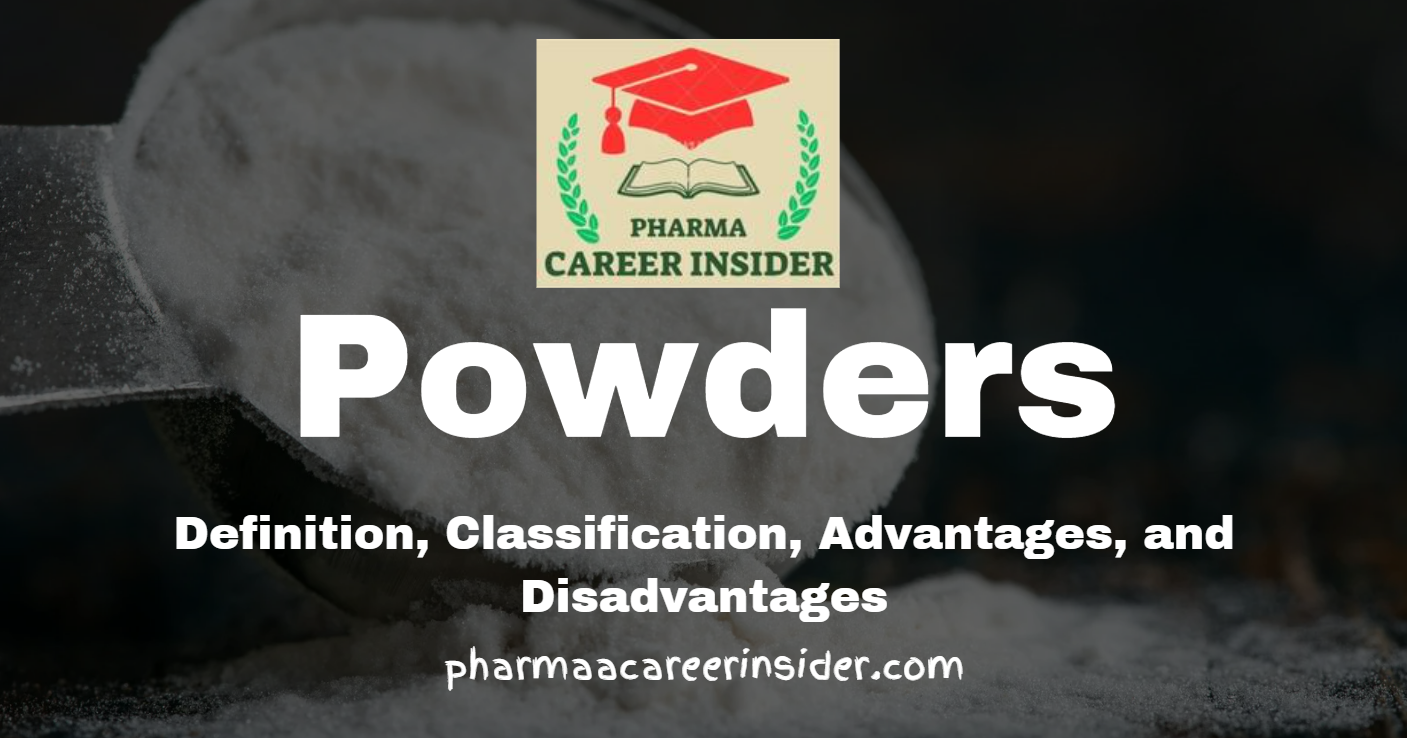Powders are solid dosage forms of finely divided drug substances and/or other active ingredients. They are typically dry, fine particles intended for internal or external use. Powders can be convenient and versatile for administering medications or preparing various formulations in different industries.
Classification of Powders
Powders can be classified based on various criteria, including their intended use, particle size, and preparation methods.
Classification of Powders Based on intended uses
Powders can be classified based on their intended uses, which typically fall into two main categories: internal and external.
1. Internal Powders
a. Oral Powders:
– Bulk Powders: These powders are relatively larger particles and may have a gritty texture. They are often used when the taste is not an issue and the patient can tolerate a coarser texture.
– Divided Powders: These powders have finer particles and are intended for reconstitution in liquids before administration. Divided powders are often used when precise dosing is required and the patient prefers a smoother texture.
– Effervescent Powders: These powders combine a medicinal agent and effervescent salts. When dissolved in water, they produce a pleasant effervescence, making them suitable for oral consumption.
b. Topical Powders:
– Dusting Powders: Intended for external application to the skin. These powders often contain antifungal or antibacterial agents and are used to treat skin conditions such as infections or irritation.
2. External Powders
a. Inhalation Powders:
– Inhalation powders: Designed to be delivered to the respiratory tract, these powders are often used to treat respiratory conditions. They are finely divided to ensure proper delivery to the lungs.
b. Dental Powders:
– Tooth Powders: Powders intended for cleaning and maintaining dental hygiene. They may contain abrasive agents and flavoring to enhance their cleaning properties and taste.
c. Ear Powders:
– Ear Powders: Used for external application in the ear. These powders may contain antimicrobial agents or other ingredients to treat ear infections or conditions.
Classification of Powders Based on Particle Size
Powders, a common dosage form in the pharmaceutical industry, can be classified based on their particle size. This classification is crucial as it influences various characteristics, including dissolution rate, bioavailability, and ease of administration. The two main categories are bulk powders and divided powders.
1. Bulk Powders:
– Description: Bulk powders consist of larger particles and typically have a coarser texture. They are not required to be finely ground.
– Particle Size Range: The particles in bulk powders generally have a size greater than 180 micrometers.
– Purpose: Bulk powders are often used when the texture or coarseness of the powder is not a significant concern. They are suitable for situations where precision in dosing is not critical and the ease of manufacturing or handling is prioritized.
2. Divided Powders:
– Description: Divided powders consist of finer particles intended for reconstitution in liquids before administration.
– Particle Size Range: The particles in divided powders typically size less than 180 micrometers.
– Purpose: Divided powders are used when precise dosing is required, and patients may prefer a smoother texture. They are often reconstituted into liquid before ingestion, providing a more palatable and easily administered option.
Classifying powders based on particle size into bulk and divided powders is fundamental in pharmaceutical formulation. Understanding the impact of particle size on dissolution, bioavailability, and patient acceptability allows for the tailored design of powders to meet specific therapeutic and patient needs. This classification ensures that powders are effective in delivering therapeutic agents and are well-tolerated and convenient for patients.
Classification of Powders Based on Preparation
Powders can be classified based on their preparation methods, considering the processes involved in their formulation. The main categories include simple or powder mixtures and compound powders.
1. Simple or Powder Mixtures:
– Definition: Simple powders, also known as powder mixtures, are composed of a single active ingredient or a mixture of active ingredients. They are created by blending and intimately mixing the powdered substances.
– Composition: Simple powders can contain one or more pharmacologically active substances and inert excipients or diluents.
– Examples: Aspirin powder, where aspirin is the sole active ingredient or a mixture of two different antibiotics for a specific therapeutic purpose.
– Application: Simple powders are often used when a straightforward administration of a single or mixed active ingredient is required.
2. Compound Powders:
– Definition: Compound powders combine two or more ingredients, including active pharmaceutical ingredients (APIs), diluents, binders, disintegrants, and flavoring agents.
– Composition: These powders are more complex, containing a formulation of multiple components carefully combined to achieve a specific therapeutic or manufacturing objective.
– Examples: Powder formulations designed for oral reconstitution, combining the active ingredients with excipients for stability and palatability.
– Application: Compound powders are used when a specific combination of active and inactive ingredients is necessary to achieve the desired therapeutic effect or when specific characteristics, such as taste masking or controlled release, are required.
Classifying powders based on preparation methods, whether simple or compound, is essential for ensuring the effective delivery of pharmaceutical agents. It allows for a tailored approach to formulation, considering the complexity of therapeutic goals and the characteristics required for optimal patient outcomes. Understanding the distinction between simple and compound powders aids healthcare professionals in prescribing and administering medications accurately.



